Alt Trans
This tunnel’s made for singin’
October 1, 2014
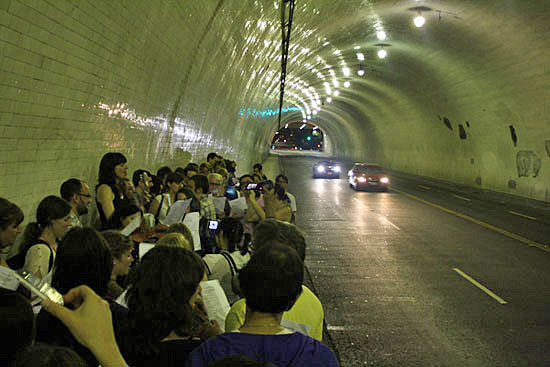
This tunnel, minus the cars, will be the site of one of CicLAvia's more unusual entertainment offerings.
If you’ve ever made your way through the 2nd Street tunnel in downtown Los Angeles, you know that it can be drab, grey, even a little spooky.
But this Sunday, thanks to the transformative car-free magic that is CicLAvia, the tunnel will turn into something else: a musical performance space echoing with the sounds of pedestrian- and cyclist-friendly numbers like “These Boots are Made for Walkin,’ ” Queen’s “Bicycle Race” and “Walkin’ on Sunshine.”
A group called Public Space Singalong is preparing to serenade those who pass through the tunnel—on bike or on foot—with lively tunes from the 1950s through the 1980s, as musicians provide accompaniment on guitar, violin, snare drum and accordion.
Jessica Cowley, the group’s founder, said everyone is welcome to join in—musical talent optional.
“It’s an opportunity to make music with other people in a really low-stakes situation,” Cowley said. “Everything gets lost when there are 40 people. You don’t even have to sing well.”
Cowley, an urban planner by trade, started the group in 2013 to use public spaces in a new way and bring back what she calls a lost tradition—creating music with the community. They’ve sung in the 2nd Street tunnel before, but this time the slower pace of bicycles and walkers should encourage more people to stop and have a listen. The pedestrian group Los Angeles Walks is coordinating their outing with the singers, and will arrive at noon to join in.
Public song is just one of the activities planned for Sunday’s open streets extravaganza. Bike safety classes, the Festival of Philippine Arts and Culture, interactive poetry, live music, and rock climbing are all part of the day’s offerings, which will be held throughout the event’s sprawling ”Heart of L.A.” route.
Food will be prominently featured, too. In August, CicLAvia’s organizers got mouths watering in advance with a food photo contest that featured dishes from eateries along the route. In addition to the restaurants, attendees can get their grub on at gourmet food trucks, which will be stationed at event “hubs,” or at the Historic Core Farmers Market, which is located nearby.
It all takes place from 9 a.m. to 4 p.m. this Sunday, October 5. This will be the 10th edition of CicLAvia, which regularly draws crowds in excess of 100,000. It won’t be the last, though—on December 7, the event heads to South L.A. before making its first-ever trip to the San Fernando Valley in the spring of 2015.
Posted 10/1/14
Valley date with CicLAvia [updated]
August 21, 2014
It’s been downtown, to East L.A. and to the beach, but one major part of town—the sprawling and populous San Fernando Valley—has been left out of the CicLAvia fun. All that changes on March 8, 2015.
That’s when the hugely popular open streets event is set to roll down two well-known Valley thoroughfares, Ventura and Lankershim boulevards. The car-free route now being finalized will stretch down Ventura from Coldwater Canyon to Lankershim, then dog-leg north on Lankershim to Chandler Boulevard, where Metro’s Orange and Red lines meet.
Zachary Rynew, who serves as a volunteer “bike ambassador” to the Valley for the Los Angeles County Bicycle Coalition, said the event will energize cyclists in a community that traditionally has lagged behind areas of the city where bike culture has more fully taken hold. With its flat, wide streets, the Valley is ripe to emerge as a cycling hot spot, Rynew said.
“CicLAvia is really going to be an eye-opener,” he said. “The Valley can work at a bicycle scale, it’s just that people need the confidence to get out there on the streets and feel comfortable.”
Aaron Paley, CicLAvia’s co-founder, said details of the event still need to be worked out, but outreach to community and business stakeholders already is underway. Two weeks ago, he and his staff pedaled the route themselves to get a street-level view. Paley plans to continue engaging the community over the next few months before releasing a formal announcement, complete with maps, around the beginning of 2015.
The route’s nexus with major transit lines and bike paths along the Orange Line, Chandler Boulevard and parts of the L.A. River is intended to make the event convenient and accessible for cyclists, pedestrians, skateboarders, scooter-riders and hula hoopers who want to spend the day car-free.
“When we thought about doing the first one in the Valley, I really wanted to pick up on the infrastructure,” Paley said. “We planned it around the Red and Orange lines.”
Buses and trains will play a big part in moving people to and from the Valley CicLAvia, which is expected like previous events to attract more than 100,000 participants. Avital Shavit, project manager of Metro’s open streets program, said transit accessibility was one of the key criteria evaluated under a grant program that awarded the Valley event $366,773 in June.
“CicLAvia has had a direct effect with promoting ridership on Metro,” Shavit said. On the Red and Purple subway lines, she said, “ridership has gone up an average of 25% on the day of CicLAvia events over the past three years.”
She added: “It’s a way to get people to try Metro for the first time. They’re coming to a car-free event and thinking ‘How are we going to get there?’ One great way is by taking Metro.”
The event’s route will pass by major entertainment landmarks like Universal Studios and interact with community staples like the Studio City Farmers Market. Additionally, CicLAvia’s Paley wants to focus on the resurgent waterway that runs through part of the route. “I want to do something related to the revitalization of the L.A. River in the Valley,” Paley said, referring to greenway projects that have made major bike, pedestrian and environmental improvements to sections of the river.
For people like the bike coalition’s Rynew, a 30-year Valley resident, the most exciting prospect is being able to show certain people what they’ve been missing.
“The great part of CicLAvia is that you get to showcase your neighborhood to the rest of the city,” Rynew said. “The last three years has been the most exciting time in the Valley’s development, with the NoHo arts district and all these great restaurants going in on Ventura Boulevard. I think people that are afraid to go over the hill are going to see the Valley in a whole different light.”
Updated: 8/22/14: A spokesman for Los Angeles City Councilman Paul Krekorian emphasized Friday that the date for the proposed San Fernando Valley CicLAvia, provided by the organization’s executive director, has not been finalized and could potentially change in the weeks ahead. There could also be revisions in the route as input is sought from neighborhood residents and businesses, said spokesman Ian Thompson. Krekorian’s council district includes the San Fernando Valley.
Posted 8/21/14
New CicLAvias to hit the road
June 12, 2014
L.A. has tasted CicLAvia, and it wants more.
In early 2010, as preparations were being made for Los Angeles’ first car-free, open streets event, Santa Monica organizers were brainstorming doing the same thing in their city. While CicLAvia blasted off that October, quickly drawing crowds in excess of 100,000, Santa Monica’s plans never got rolling.
Cynthia Rose, director of the bike advocacy group Santa Monica Spoke, said that despite having an active cycling and walking community, her city simply didn’t have enough resources.
“We were not as far along and just did not have the money that CicLAvia had,” says Rose.
Enter Metro.
A year ago, the transportation agency launched a grant program to fund open streets events—closing streets so people can bike, walk and frolic freely—with the goal of spreading the CicLAvia love to more places. Nearly two dozen applications were received in April, and 12 were accepted in the first cycle of grants made public this week. Pending approval by Metro’s Board of Directors, the agency will spend $4 million during the next two years to bring 12 events to places like Santa Monica, Pasadena, Long Beach and the San Fernando Valley.
Rose says she’s excited that her city will now get a chance to put its unique mark on the rapidly-expanding open streets movement, which was initially inspired by mid-1970s ciclovias in Bogotá, Colombia. (“Ciclovia” translates roughly to “cycleway.”)
“This is something that the community is ripe for and really wants,” Rose says. “Ours is going to be more like a big street festival. It’s for everyone to share the street.”
The Santa Monica gathering is being planned for spring or summer of 2016, to take advantage of the excitement surrounding the opening of Expo Line Phase 2, which will extend the light-rail train from downtown L.A. to the coast. Rose hopes the event will highlight some of the investments that Santa Monica has made to improve bicycle and pedestrian infrastructure, including the Bike Center and L.A. County’s first-ever bike share program, which should be up and running in two years.
Still, a large chunk of the grant money is slated to go CicLAvia itself, with funding recommended for six major events that the organization is producing or co-producing. CicLAvia spokesman Robert Gard said the plan is to use the Metro money to reach new locations, including the San Fernando Valley, where an event is planned for spring of 2015.
“We’ve done nine events on this side of the hill and by the time we get to the Valley it will have been 11 events,” Gard said. “With all the people who come from the Valley and beyond to our events, it just makes sense.”
The proposed Valley route still must be tested and finalized, but planners envision it going through North Hollywood, Studio City and Sherman Oaks, along Ventura and Lankershim boulevards. Those streets are home to scores of shops and eateries, a thriving arts community, beautiful vistas of the Hollywood Hills and more. The route also would connect with Metro’s Red and Orange lines and several bike paths, making it easy to get there and back.
CicLAvia would like to make the San Fernando Valley a regular destination, Gard says. Future events could target other locations further west.
The Metro grants will also help smaller towns join the open-streets movement, with tens of thousands of dollars going to places like Carson, Downey and Lawndale for more modest-scale events.
“Anybody who hopes for public consciousness of bicycling hopes a ciclovia makes it into their community,” says Lars Clutterham of the Downey Bicycle Coalition. He says that, unlike Santa Monica, “Downey is in the early stages of investing in bicycle infrastructure—there is none.” Clutterham hopes that the prospect of open streets events will prompt investment in pedestrian and bicycle improvements.
Viviana Franco is the executive director of Lot to Spot, an organization behind the Lawndale Community Bicycle Ride and Open Street Event, another grant winner. She hopes Metro’s program is a tipping point for low income communities that have largely missed out on the events. Franco says that’s upsetting because people in these communities are already cycling and walking to get where they need to go, but are unable to take full advantage of the health and community-building that can come with those activities.
“CicLAvia is amazing,” Franco says. “Let’s bring it to other neighborhoods; let’s bring it to neighborhoods where diabetes and obesity are rampant.”
Under direction from its board, Metro has sharpened its focus in recent years on “active transportation,” including cycling and walking. The agency formed a Bicycle Roundtable to collaborate with the cycling community and it has invested millions in infrastructure, with more to come.
Diego Cardoso, Metro’s executive officer in charge of active transportation, says open streets events benefit all types of transportation in the county. Not only do they get people out of their cars, he says, they also get some folks to try public transit for the first time.
“They take transit because they are going to use a bike at CicLAvia, but then they learn the places it can take them.” That, Cardoso says, makes them more likely to take buses and trains in the future.
The proposed grant awards go to the Planning and Programming committee next Wednesday before reaching the full Board on June 26.
Posted 6/12/14
Bike boom’s hidden headache
May 15, 2014
There’s good news on the cycling front, with a new report showing L.A. bike use growing by 7.5% and new lanes, paths and “sharrows” buzzing with two-wheeling commuters and recreational cyclists.
But there’s also a less heralded statistic in the 2013 Bike and Ped Count released this week by the Los Angeles County Bicycle Coalition:
Only 46% of L.A. cyclists wear helmets.
That’s troubling to medical experts like Dr. Mitchell Katz, director of the county’s Department of Health Services and a (helmet-wearing) cyclist in his own right.
“The evidence from a medical point of view is very clear: helmets prevent brain injury, and brain injuries are some of the most devastating events besides the possibility that you might actually die,” Katz said.
Katz said his own experiences on the streets of L.A. corroborate the report’s findings on helmet-wearing.
“I’ve noticed that certainly more than half of the bicyclists do not. I think young people are especially guilty of not wearing helmets,” Katz said.
Those riders are taking a big chance, given that 15- to 19-year-olds were the bicyclists likeliest to land in L.A. County emergency rooms in 2012, with 64.3 per 100,000 people in that population showing up to be treated for bike injuries.
Injuries to Los Angeles County cyclists are steadily increasing, from 2,916 hurt in collisions with vehicles in 2007 to 4,759 injured in 2011, according to state data provided by the county Department of Public Health. Twenty-six bike riders were killed in 2007 and 30 in 2011. Only 14% of those injured and just 20% of those killed were using “safety equipment” at the time of their accidents in 2011.
However, the state injury data did not include a specific breakout for helmet usage within the category of “safety equipment”—something Katz said could be helpful in raising consciousness about the dangers of riding without protective headgear.
“I think there is a misconception, that people think, ‘I’m a great bicycle rider. I don’t need to wear a helmet.’ What they’re not thinking of is it doesn’t have anything to do with what kind of bicycle rider I am. It has to do with whether a car hits me and I fly through the air. You don’t have any control, once you’re flying through the air, of how you land,” Katz said.
Adults aren’t legally required to wear bike helmets in California, but advocacy groups like the Bicycle Coalition officially recommend them. And when elected officials like Los Angeles Mayor Eric Garcetti go out for a spin on Bike to Work day, they’re invariably photographed wearing a helmet.
So why aren’t more L.A. cyclists following their lead?
The answer is complicated—and, within the cycling community, often polarizing.
“It can get pretty heated once you start talking about helmet use because there’s a contingent of bicyclists who are really adamant about wearing helmets and there’s a contingent of bicyclists who are really adamant about not wearing a helmet,” said Colin Bogart, education director for the Bicycle Coalition, who advises his students to don helmets and always wears one himself.
Some people “just don’t think it’s that important…it’s the ‘it’s-not-gonna-happen-to-me’ sort of thing,” Bogart said. Then there are those sometimes called “invisible riders”—day laborers and other workers commuting by bike out of necessity and perhaps unable to afford safety equipment like helmets and lights.
And, particularly among younger riders, “there’s the whole coolness factor, right?” Bogart said. “It’s like, ‘You’re a dork if you wear a helmet.’ ”
Underlying the contentious issue is the feeling—held even by bike advocates who strongly recommend helmet use—that too much focus on headgear diverts attention from a broader mission of pushing for better, safer cycling spaces throughout the city.
“I think ultimately what we’d like to see is a situation in which our built environment is such that people don’t even feel like they need to have a helmet because they feel so safe doing it,” Bogart said. “When you look at photographs of people biking in a lot of these cities in the world where the percentage of cycling is way beyond anything we have here, almost nobody is wearing a helmet. [That’s] because it’s viewed as so everyday and so not hazardous to your safety that people just ride without ‘em. “
Although some, like Dr. Katz, think it would be a good idea to pass laws mandating helmet use for adult bicyclists as well as those 18 and under, Bogart said he believes that could deter would-be riders from joining the growing cycling movement.
“That’s a real concern, that if you make it a requirement, a lot of people are just going to say, OK, forget it,” Bogart said.
The helmet statistic was not highlighted in the bike count’s official news release. But it might dovetail with another finding: that fewer than 20% of L.A. cyclists are female. That suggests there still aren’t enough safe bikeways to attract women, traditionally considered more “risk-averse” riders.
To get more women, children and older people bicycling on city streets, the new report calls for creation of more “protected bikeways,” which carve out dedicated space for cyclists to ride with some separation from automobile traffic.
Because let’s face it: “If you’re riding on the streets as they are right now, you’re pretty risk tolerant,” said Eric Bruins, the coalition’s planning and policy director.
Posted 5/15/14
Ghostly roadside remembrances
May 8, 2014
The roadside works of art are ethereal, almost glowing, alive with flowers or flickering candles. “Ghost bikes,” as they’re called, gently command attention even on the fast-moving streets of Los Angeles.
But the white bikes’ presence goes beyond artistic provocation. They also speak to a life-and-death reality—the fact that even as bicycling in L.A. grows in popularity, too many bicyclists are being hurt or killed on our streets.
Danny Gamboa keeps a running spreadsheet of every Southern California cycling fatality. So far in 2014, 37 names have joined his list, leading to installation of white “ghost bikes” from Alameda Street to Sunset Boulevard, from Huntington Beach to Twentynine Palms.
“You strip a bike, you paint it, you go to the place where this tragedy happened and you’re basically trying to make the world a better place,” says Gamboa, a 40-year-old Long Beach filmmaker and artist who chronicled the Ghost Bike phenomenon in a documentary motion picture he made last year with his partner, Kat Jarvis. He is part of the story himself, working with a loose coalition of about a dozen volunteers who mobilize after cycling fatalities to paint and install bikes in honor of fallen friends, family members or even strangers.
“You’re trying to help the community heal and come together,” he says. “They write on the bike, ‘I don’t know you but I’m sorry for your loss.’ People bring flowers and candles and pictures. It’s a really touching tribute, and stuff like that is what keeps us going.”
This year, as Bike Week dawns in Los Angeles, Gamboa and his group are being recognized for what they do.
Ghost Bikes L.A. will receive a “Golden Spoke” award on Tuesday, May 13, as part of the 11th annual “Blessing of the Bicycles” event at Good Samaritan Hospital. The honor—bestowed as part of a cavalcade of bike events including Bike to Work Day and a Bike Night at Union Station—strikes a poignant note among the more festive observances.
“It’s very moving when you drive around and you see a white bike. It’s kind of eerie,” says Katrina Bada, manager of marketing and public relations at Good Samaritan. “It’s a way for us to show our support of the bicycle community and a memory of those who perished.”
Gamboa’s fellow volunteers come from all over: the San Fernando Valley and other parts of L.A., Ventura and Orange counties, the Inland Empire. “We like to do it as a group. It’s something we do for safety reasons and also because it’s such a somber thing that we make it a point to afterwards go out to have a bite to eat and have a discussion… on what happened, things that can be done so that it doesn’t happen again.”
The ghost bike phenomenon is believed to have originated in St. Louis, Missouri, about a decade ago, and has since spread worldwide. Gamboa, an avid cyclist, knew that people had been putting up cycling memorials around Southern California for years. But he hadn’t gotten involved personally until 2011, when he went along with friends as they installed a ghost bike to honor triathlete Amine Britel, who’d died bicycling in Newport Beach.
“He was hit from behind and killed, and from that very first night, it just got ahold of me,” Gamboa says. “I was like, this is really powerful, it’s really important.”
In addition to his hands-on efforts installing the memorials, Gamboa also curates art shows that include images of ghost bikes, like the “Bike Love” pop-up exhibition now on display at the Museum of Ventura County. Despite the somber reason for the work, Gamboa says it is all ultimately uplifting.
“It’s like a calling,” he says. “You’re tired, you just had a full day of work, and then something happens. You basically just pull yourself up by your little bootstraps and you go out there in the middle of the night, somewhere you’ve never been, tributing someone that you don’t know, and it doesn’t matter…We’re all equal, we’re all on bikes, and they’re one of us.”
Posted 5/8/14
Spreading the CicLAvia spirit
April 3, 2014
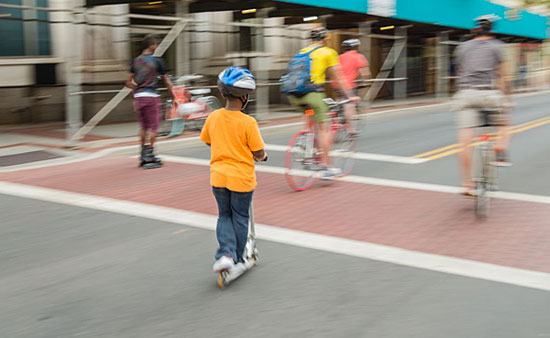
Folks from New Brunswick, New Jersey, above, to Santa Cruz are catching CicLAvia fever. Photo/Frank Villafañe & Rose Rios
Everybody wants to play in the streets these days.
And CicLAvia, a stereotype-busting open streets free-for-all that became an overnight sensation when it rolled into Los Angeles four years ago, has grabbed the handlebars of what’s becoming a nationwide movement, from small towns to big cities.
As 2014’s first CicLAvia prepares to cruise down a car-free Wilshire Boulevard Sunday, L.A. is hosting the first-ever Open Streets National Summit, drawing activists from around the country who want to see how a metropolis allegedly addicted to automobiles is using CicLAvia to reinvent itself.
Summit organizer Michael Samuelson said L.A. was chosen precisely because of the success of CicLAvia, which regularly draws crowds in excess of 100,000.
“L.A.’s got a fantastic thing going,” said Samuelson. “It’s incredibly popular; the streets are packed with people biking and walking every time.”
The Open Streets Project is working in close collaboration with the CicLAvia organization, which will give summit attendees a behind-the-scenes look at one of the most successful open streets initiatives in the nation, said Aaron Paley, executive director and co-founder of CicLAvia. Paley said that the inherent challenges in shutting down major roads in a city like L.A. are a big part of the success story.
“We are the car capital,” Paley said. “There’s this idea that if you can do it in L.A., then the sky’s the limit.”
CicLAvia started in October, 2010, as a once-per-year event inspired by mid-1970s ciclovias in Bogotá, Colombia. (“Ciclovia” translates roughly to “cycleway.”) By 2013, CicLAvia had grown to three events a year. Paley said that he expects L.A. County to get even more open streets events like CicLAvia as funding grows. “There will probably be 10 or 12 events happening around the county each year,” he said.
As CicLAvia gears up to play an even bigger role in L.A., other communities across the country are hopping aboard. As recently as 2007, only eight or nine open streets events were being held across the country, according to Samuelson. Now, they’re taking place in more than 100 cities across North America.
Some of the initiatives, like Sunday Streets in San Francisco and Summer Streets in New York City, have been serving large, bike-savvy populations for years. But the movement is also gaining traction in cities like New Brunswick, New Jersey (pop. 56,000), which held its first ciclovia last October.
“People were asking ‘Why are we doing this?’ They focused on the negative,” said Jaymie Santiago, organizer of the event and director of program operations for New Brunswick Tomorrow. “It exceeded all our expectations. We expected 2,000 people and got 4,500.”
Building on those results, New Brunswick Mayor James Cahill doubled down, partnering with the organization to produce three more ciclovias this year, starting May 4. Santiago is attending this weekend’s summit so he can bring home valuable lessons and perspective.
“Because of the scale of Los Angeles, it sets an example for smaller cities,” Santiago said. “If L.A. can do it, then New Brunswick can do it.”
At the summit, Santiago plans to share some of the early success of his event, which he said is a useful tool in his organization’s fight against poverty in New Brunswick. “One of the symptoms of poverty is isolation,” he said. “By hosting an event like this and reclaiming the streets, it kind of breaks through that.”
Jenn Graham, an organizer for Atlanta Streets Alive in Georgia, hopes the summit will provide her with ideas on how to partner with her city better. “Our event sticks out like a sore thumb because it’s one of the few that’s not organized by the city or in partnership with a city,” she said. While Atlanta Streets Alive has been able to draw some funding from the city of Atlanta, it has relied primarily on cooperation with businesses and nonprofit organizations. Still, Atlanta Streets Alive has grown rapidly, from about 1,500 people in 2010 to 83,000 last October.
Closer to home, Saskia Lucas of Santa Cruz Open Streets said she is “totally excited” to get her first taste of what she called “the largest open streets event in the United States.”
“I’ve watched videos online and it is just so inspiring to see these thousands of Angelenos just taking over major Los Angeles streets with smiles plastered on their faces.”
More of those smiles may be on tap. Last summer, Metro’s Board of Directors invested $2 million in expanding open streets events to all parts of Los Angeles County. A few months later, the board approved a grant program for local groups seeking to produce events.
The Open Streets summit starts on Friday, April 4. About 75 organizers from across the country will gather at the Line Hotel in Koreatown to share ideas, stories and advice on everything from how to grow partnerships with cities to the technical aspects of producing a safe and successful event.
Things culminate with Sunday’s CicLAvia, which will run from downtown to LACMA, in the Miracle Mile district. Locals and visitors alike will be saying so long—for now—to the six-mile long “Iconic Wilshire Boulevard” route, which is going on hiatus as construction of the Purple Line Extension prepares to get underway.
But never fear: This is Los Angeles, where another CicLAvia always seems to be right around the corner. The next one is coming on October 5 in the “Heart of L.A.” Then, on December 7, the route will focus primarily on South L.A. for the first time ever.
Posted 4/3/4
Metro’s bicycle brain trust
February 25, 2014
There was once a time, not long ago, when bicyclists weren’t much more than a squeaky wheel to Metro—and not in a good way.
What a difference four years makes.
On February 19, 2010, the cycling community got a seat at the transit table when Metro hosted its first Bicycle Roundtable meeting.
It was the beginning of an important collaboration—one that would lead to some major improvements for cyclists within the Metro system. But you wouldn’t have known it from the rocky start of the process, as cyclists started engaging warily with a government agency that hadn’t always been so welcoming.
“They distrusted us and were very assertive about issues we needed to address and policies we needed to embrace,” said Diego Cardoso, Metro’s executive officer in charge of the bicycle and pedestrian program. “Those were the days when Metro was transitioning as an agency in terms of mobility and bicycling in L.A. County.”
Intended as a forum for bike advocates to exchange ideas with the transit agency, the meetings grew out of a rising tide of vocal cycling activism. “The bicycle community was demanding in terms of getting Metro, cities and the county to deal with issues of how to improve mobility for bicycles,” Cardoso said. “We said ‘Well, let’s bring them together.’ ”
Though contentious at first, the discussions soon evolved in ways that have helped shape the emergence of cycling as a major mode of transportation in the county.
One of the earliest results was the end of a ban that kept bikes off trains during peak periods of travel. What’s more, the agency has even removed seats from rail cars to clear more room for cyclists to bring their rides aboard. And Metro has more than doubled the share that bicycles get in its competitive Call for Projects program, which funds local initiatives with regional significance. (Cycling programs now get 15% of the pot, which in the last cycle totaled $199.4 million.)
The collaboration also has led to new public education programs promoting safety. The highly visible “Every Lane is a Bike Lane” campaign grew out of roundtable discussions, and last summer, Metro launched bicycle safety classes taught by advocacy groups that attend the meetings.
On the political side of things, Metro’s Board of Directors has provided support as well, officially recognizing bicycling as an official “mode of transportation,” putting it on equal footing with motorized travel.
Next up: bike-sharing.
“Bike share is a good example where they basically asked ‘What do you think?’” said Eric Bruins, director of policy and planning for the L.A. County Bicycle Coalition. “Feedback from the roundtable was very clear—there should be one regional vendor and we want to see a strong leadership role from Metro.”
The agency, spurred by a motion by Mayor Eric Garcetti, Supervisor Zev Yaroslavsky and others, stepped in after the city of L.A.’s bike share program foundered and took the lead in creating a county-wide bike sharing plan. In December, Metro’s board expanded the agency’s role, directing it to fund the plan by teaming up with local jurisdictions.
An update on the bike share project’s progress—including input from the roundtable group—is scheduled to come before Metro’s board in April. According to Cardoso, the agency is in the process of contracting with an outside company to help implement the program, with Los Angeles, Santa Monica and Pasadena serving as pilot cities.
Another upcoming project aims to build five new “bike hubs,” structures that will offer secure parking, repairs and other resources, at major public transportation hotspots. The first one, at El Monte Station, will open later this year. Other hubs are planned for Union Station, Culver City Expo Line Station and two Red Line stations—Hollywood/Vine and North Hollywood.
The roundtable’s most recent meeting earlier this month drew a mix of cycling aficionados, staff from government agencies and the offices of elected officials and even a couple of unaffiliated members of the public. Attendees came from all over: Santa Monica, Montebello, even Orange County.
One regular participant, Dennis Hindman, 61, of Toluca Lake, said he’d like to see more folks from the public take part in helping the agency get more of a grassroots perspective. “It gives you the insight of actual experience,” he said. “You may have missed something from a practical standpoint that just won’t work in real life.”
Miguel Ramos, a volunteer for Multicultural Communities for Mobility, was attending for the first time. Ramos’ mission is to promote inclusion of all of the region’s diverse communities in bicycle projects—something he said is simply “not happening in low income communities” nationwide.
“These communities already have a growing bicycle culture,” Ramos said. “It’s about recognizing that fact and allowing their voices to be heard.” To achieve that, he said, Metro must increase outreach in multiple languages.
For his part, Bruins of the Bicycle Coalition said he would like to see a higher level of participation by a broader range of Metro staffers.
“Metro has many departments,” Bruins said. “We’d like to see other departments come to the bike roundtable because it’s really that exchange of ideas that’s helpful. The folks that are designing the next set of light rail vehicles came and presented designs of how bikes can be stored on board. Those are great discussions because they allow departments that don’t usually deal with the bike community to interface with us.”
Even today, bicyclists and the agency don’t always see eye-to-eye. Many cyclists are pushing for the installation in rail stations of “bike channels”—deep grooves next to stairways to make it easier for bikes to get up and down. That, however, would be expensive, and retrofitting existing stations with the channels would be even costlier, said Laura Cornejo, who oversees Metro’s Active Transportation Program and has led the past two roundtable discussions.
“Advocates are pushing for Metro to do more and be a little more aggressive,” Cornejo said, “but we have to be strategic and take baby steps to get to the final destination.”
But, she added, the days of bicycles as an afterthought in L.A. are long gone.
“All the trends point to bicycling growing,” Cornejo said. “We’ve seen it on rail, where bicycle boarding has increased about 40% in just one year. I don’t see the trend reversing or slowing.”
Posted 2/25/14
Cycling’s marquee player
January 29, 2014
A “Super Bowl Sunday Funday Warm-Up Ride” offers a healthy diversion before the coming onslaught of game day nachos, truck ads and football.
Next month, a benefit screening of the 1979 feel-good cycling flick “Breaking Away” gives a boost to “Operation Firefly,” a program of the Los Angeles County Bicycle Coalition (LACBC) that provides bike lights to folks who need them to ride safely at night.
And in April, “Climate Ride California” spins through the northern part of the state, raising funds for non-profit environmental and alternative transportation organizations, including the LACBC, which is sending a team.
A common denominator in all three events? Greg Laemmle, president of the 75-year-old local theater chain and an increasingly visible advocate for bicycling in Los Angeles.
These days, in fact, it’s hard to miss him: he’ll be the guy leading that Super Bowl Sunday ride from the North Hollywood Red Line station to Griffith Park and back. (He did it last Super Bowl Sunday, too, with an L.A. football history-themed itinerary stretching from the Coliseum to the Rose Bowl.)
He’ll also be at the “Breaking Away” fundraiser, which takes place Feb. 12 at Laemmle’s NoHo 7. And he’s captaining the LACBC’s team for the Climate Ride, which is being promoted with a “Ride with Greg Laemmle Contest” featuring movie pass prizes and contributions toward riders’ fundraising goals.
In other words, he may be an off-screen player in the movie biz, but in the local cycling world, he’s an above-the-line star.
“He’s a great face for our cause and the set of causes he supports,” said LACBC executive director Jennifer Klausner, noting that the Laemmle name is “synonymous with Los Angeles,” especially among art film devotees.
“We feed on the passion that he has for a wonderful future vision of a liveable Los Angeles,” Klausner said.
Although Laemmle, 48, has early memories of riding his bicycle at the beach and to Franklin Elementary School in Santa Monica, it wasn’t until gas prices spiked in 2007 that he felt moved to take things to the next level. He became a bicycle commuter between his home in Century City and his company’s office over the Royal Theater in West L.A.
Since that time, he has joined the LACBC board and become something of a two-wheeling role model, hoping to persuade fellow Angelenos to give cycling a try, particularly for the most common trips of three miles or less.
Beyond his daily bike commute, Laemmle and his wife, Tish, a top fundraiser for the popular annual River Ride, bicycle all over town.
“It’s crazy to get to the Hollywood Bowl by car, and sometimes it’s a lot of fun to ride your bike there,” Laemmle said. “I ride to Dodger Stadium and, to their credit, the Dodgers have added bike parking. We rode downtown to see a play yesterday at the Ahmanson.”
The couple ended up taking the Expo Line home from that one—making it a “multi-modal” outing involving both bikes and light rail.
“As Metro expands, the opportunity to combine Metro transit with bicycling really opens up a lot of possibilities for getting around,” Laemmle said.
He acknowledges that there are dangers out there for cyclists interacting with cars on L.A. streets, although he said he hasn’t personally experienced any mishaps.
“I have almost never encountered a situation where a driver is aggressively acting in a dangerous manner,” Laemmle said. “For the most part, people are really kind. As long as you’re happy about sharing the road, a lot of people are prepared to do that.”
Off the road, Laemmle, as a third-generation movie guy, naturally has some cinematic cycling favorites that cut across genre lines.
“ ‘Breaking Away,’ that’s an obvious one. There are definitely some other good bike movies, too. ‘The Bicycle Thief.’ And ‘Pee-wee’s Big Adventure’ has some nice bicycling scenes.”
Laemmle’s bike-friendly world view shows up in his workplace, where he has installed showers for the use of fellow bike commuters. Those include his dad, Bob, the firm’s chairman, who has now retired but still comes to the office regularly on two wheels.
Greg Laemmle said some have questioned whether bike advocacy makes sense for a business owner’s bottom line.
“I was at one point advocating for bike lanes on Lankershim, in front of where the NoHo theater opened up two years ago, and there was a comment, ‘I doubt Mr. Laemmle really wants bike lanes if they’re going to slow cars down,’ ” Laemmle recalled.
Actually, yes he does. “First and foremost, we have to be forward-looking, both from an environmental standpoint but also from a business standpoint. Most studies will show that neighborhoods that slow traffic down…and have bike infrastructure and pedestrian infrastructure and so forth, actually see an increase in business.”
And then there’s this:
“If you don’t have to own a car, or can share a car between a couple, that’s a lot of savings. And, you know, those savings translate into more money to spend at restaurants and doing stuff locally. So for what you save not having to pay for parking when you go the movies, you can buy a tub of popcorn,” Laemmle laughed.
Posted 1/29/14
CicLAvia plans three for the road
January 23, 2014
Better check the air in your tires and dust off the bike bell: more CicLAvias are heading our way in 2014.
The popular, car-free, open streets event for cyclists and pedestrians will be heading back to Wilshire Boulevard on Sunday, April 6. The “Iconic Wilshire Boulevard” route runs from downtown L.A. to the Museum Row district in the Miracle Mile.
Next up is “Heart of L.A.” on October 5. The route includes downtown L.A., along with parts of Echo Park, East Los Angeles and Chinatown.
Then CicLAvia travels to south for the first such event centered in South Los Angeles on December 7. That route will include Leimert Park and the Central Avenue corridor.
More details of the three events are here.
Posted 1/23/14




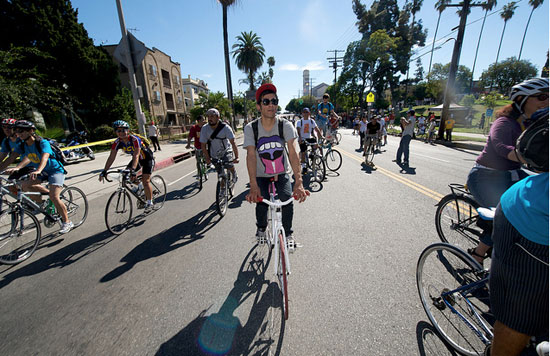
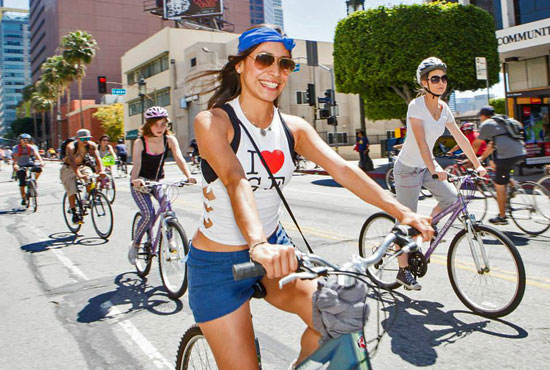

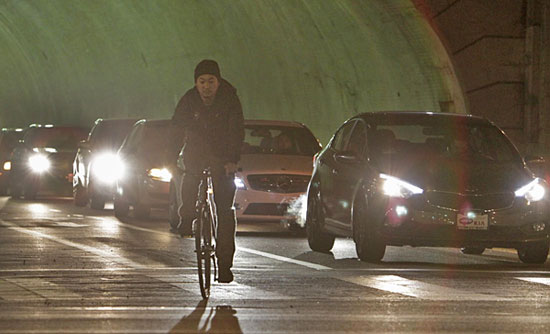
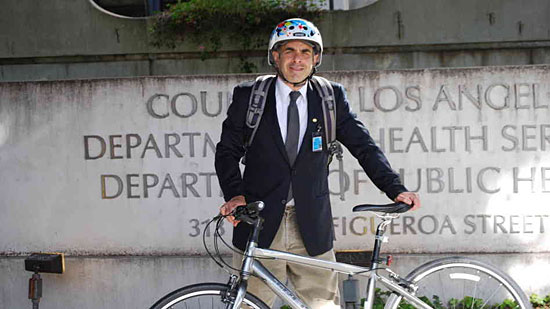
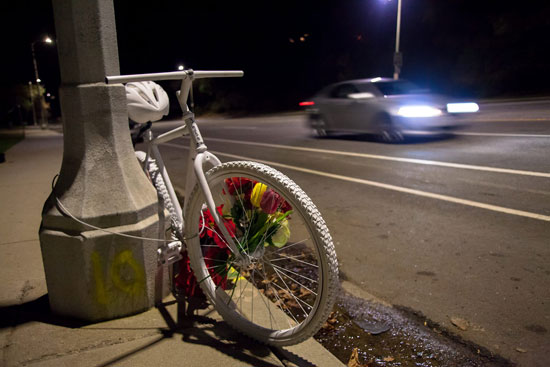
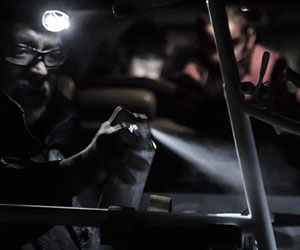
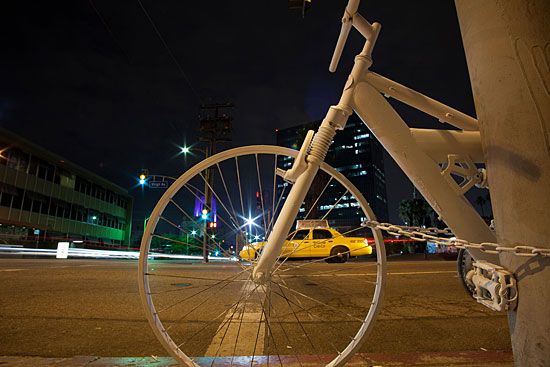
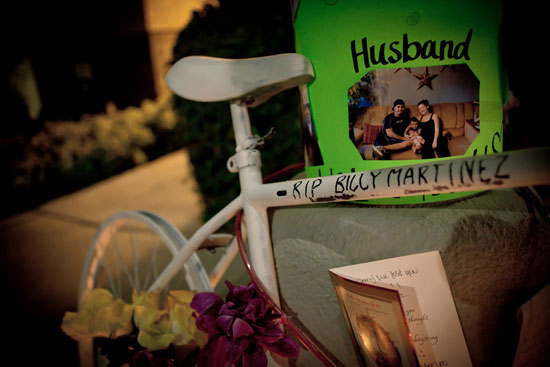
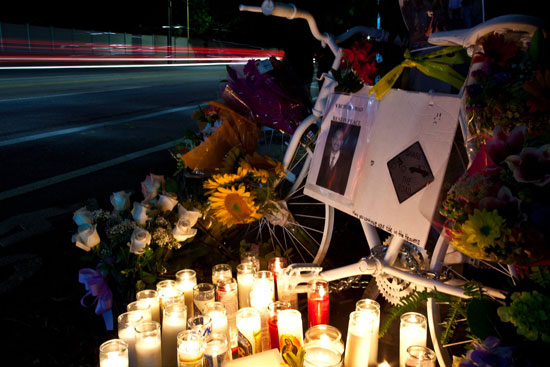
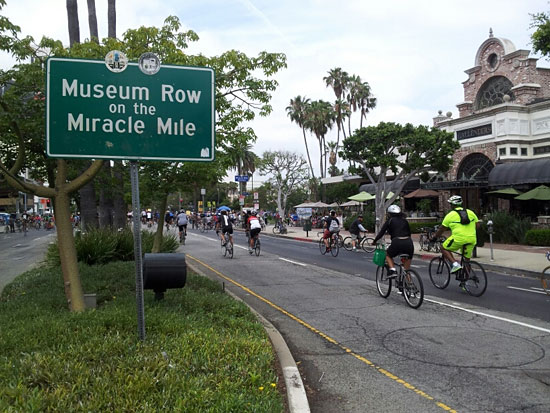


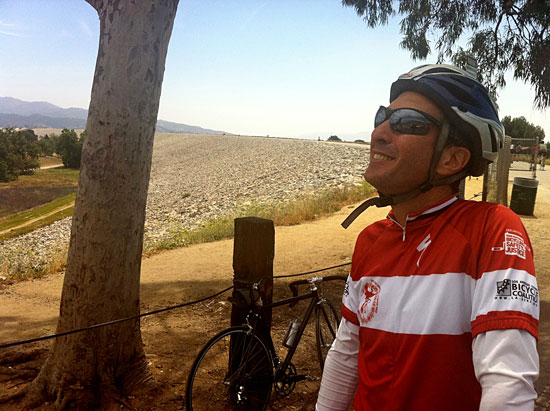
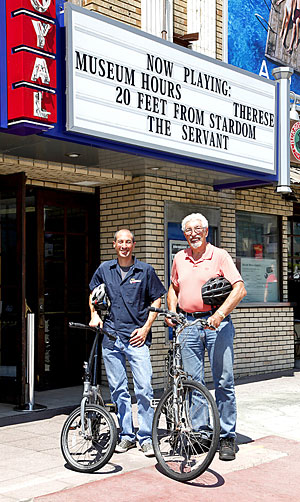
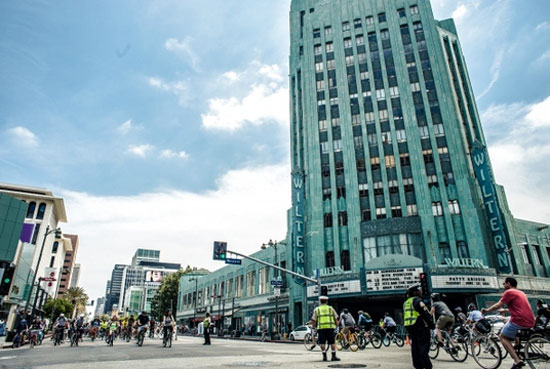







 405 bridge work causes a stink
405 bridge work causes a stink

